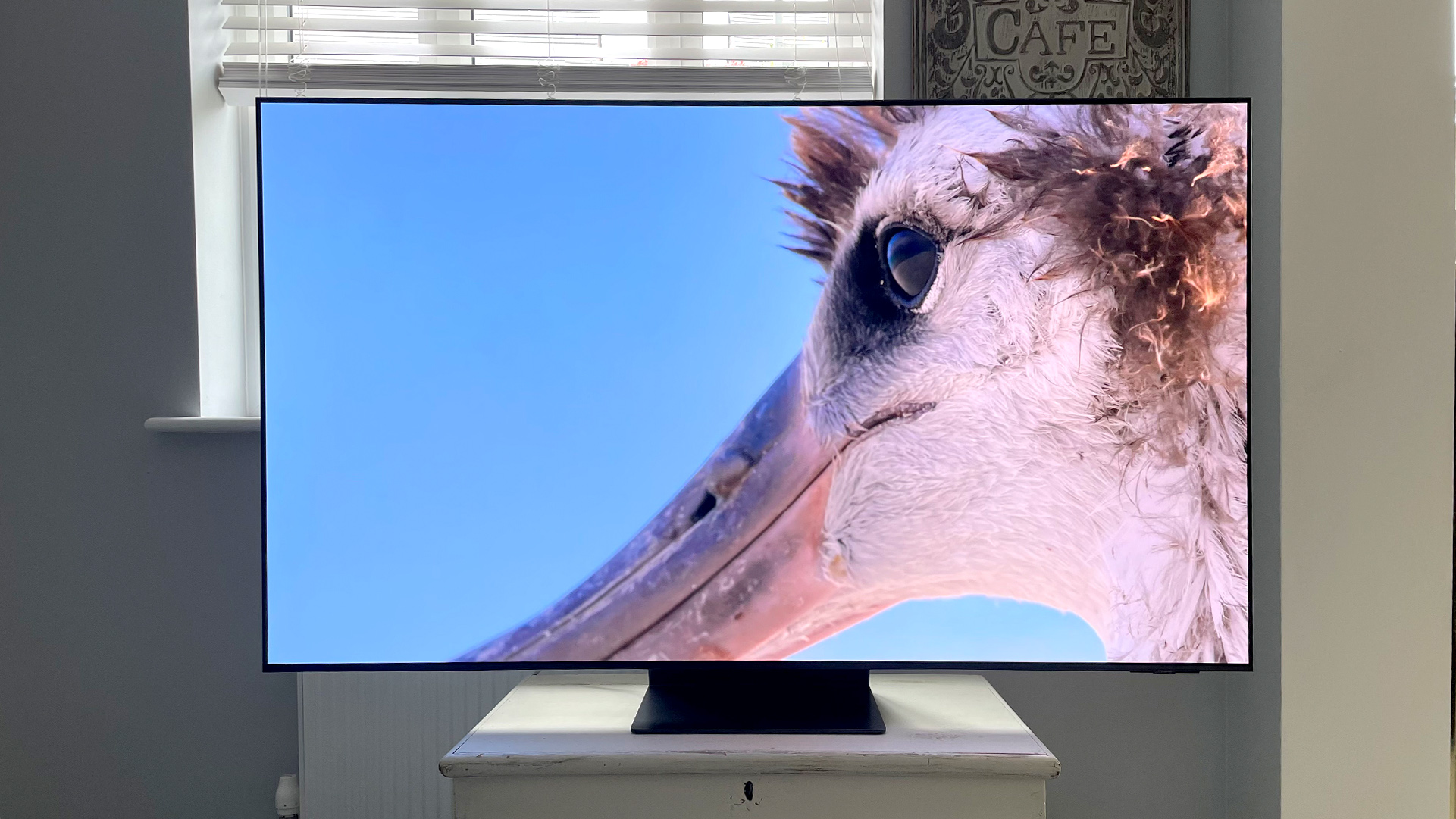
Samsung has delivered the first OLED TV of 2024, in the comely shape of the S95D. This new set, here reviewed in its 65-inch guise, brings us the third generation of Samsung’s Quantum Dot take on OLED technology – and even though its previous generation already gave us a big improvement over the first, nothing could have truly prepared us for just how much of leap forward the Samsung S95D represents.
Price
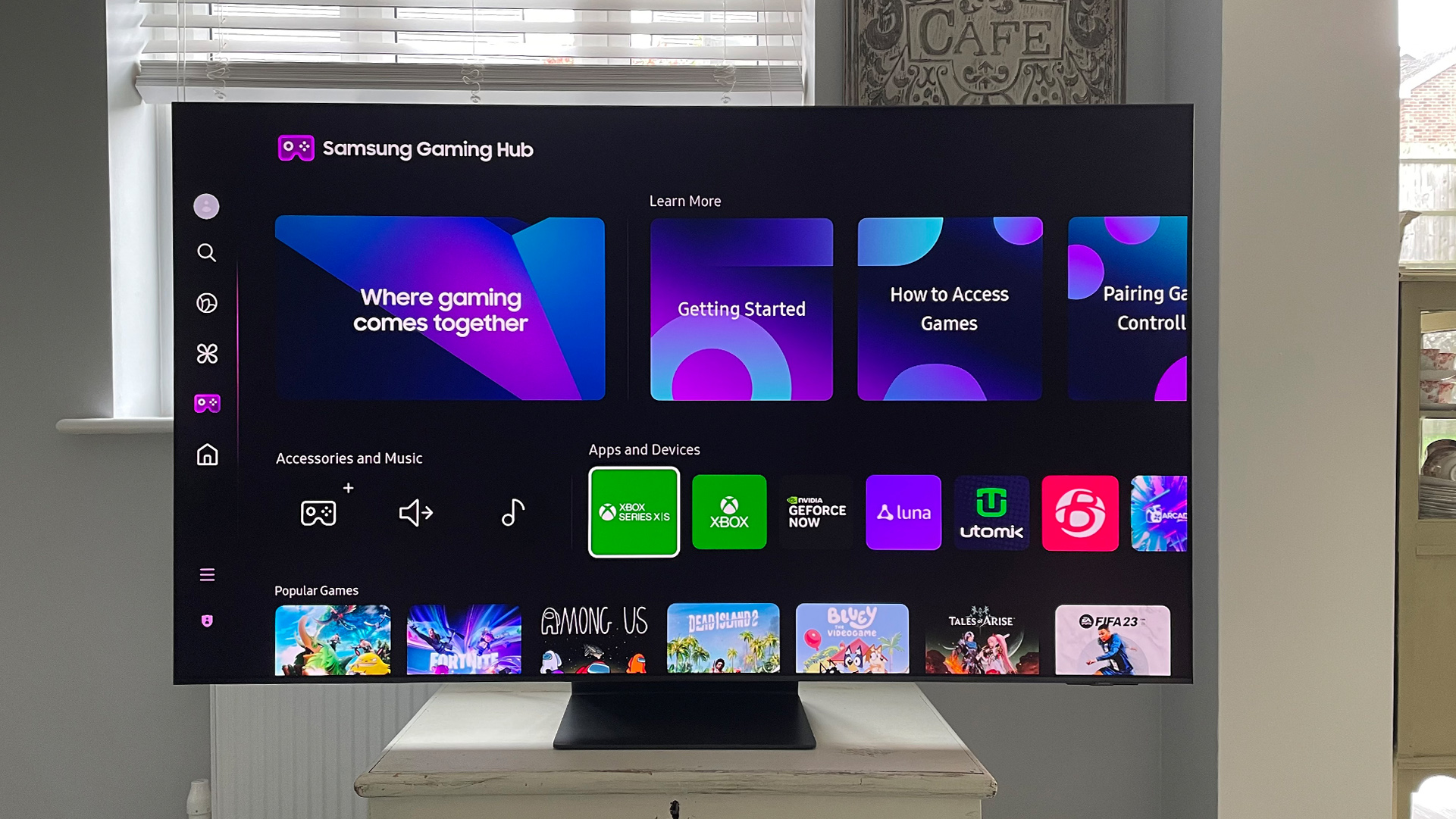
- The same price that the S95C was at launch
- Slightly more expensive in the US
- Still a very premium proposition overall
Happily, the widespread inflation of the past year or so hasn’t impacted the Samsung S95D’s price in the UK: the 65-inch version on test here (QE65S95D) is launching at £3599 – exactly the same price that the 65-inch S95C launched at. The same is true in Australia, where the full model number is QA65S95D and the price is AU$4999.
In the US, where the TV is known as QN65S95D, the price has crept up by $100 to $3400, but honestly, having seen what the TV can do, we feel most AV fans will think it’s worth it.
One other interesting thing to note about the 65-inch S95D’s price is that it undercuts that of Samsung’s 65-inch QN95D Mini LED flagship TV by £100 / $100 (we don’t yet have Australian pricing for that one). So while Samsung is talking this year about its QD-OLED and Mini LED TVs as being equally great options for different people, the pricing suggests the brand still holds a small premium flame for the QLED technology it’s been working with for so much longer than QD-OLED.
Design
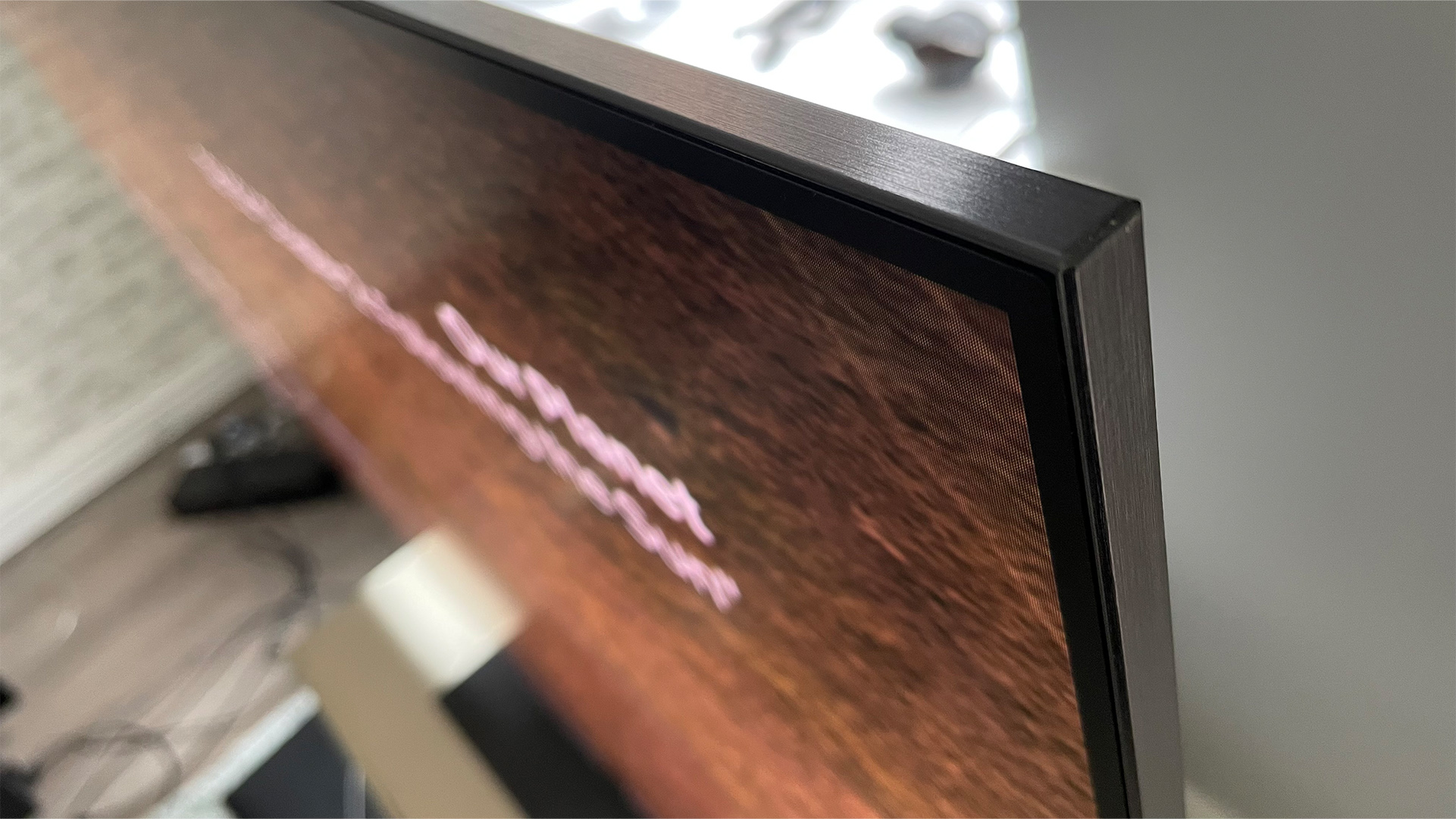
- Incredibly slim and stylish
- External One Connect box for connecting power and sources
- Two remotes, one of which is charged by room lights
The Samsung S95D is a gorgeous chunk of TV. Or rather, a gorgeous sliver of TV.
At a uniform 1cm-deep it’s one of the slimmest, most lip-lickingly wall-hangable TVs there has ever been. A slinky monolith that has no right to be capable of delivering the powerhouse pictures we’re going to be describing later.
If you’re not interested in wall-hanging your TV, don’t worry: the S95D does ship with a desktop stand. This is a pretty attractive item too – robustly built from heavy-duty metal and attached under the screen’s middle so that the TV can fit easily on even narrow bits of furniture. The rear panel features an appealing corrugated look, too, for anyone who likes to wander around the back of their TV for some reason. A TV this slender, though, really does feel like it belongs on a wall.
The bezel around the screen is impressively slim too, ensuring that your focus remains on the dazzling pictures the TV is playing rather than the technology that’s producing them.
Despite its ultra-slim profile, the S95D still carries a bank of eight good-sized midrange audio drivers splayed across its rear. While this is promising on one level, though, it’s hard to imagine these drivers being able to generate much power and dynamic range with so little chassis depth to work with, but we’ll come back to this later.
The only reason the Samsung S95D can manage to be so slim is that it ships with an external One Connect box that houses all of the TV’s connections and processing. This box means that you only need to run a single, light-coloured cable into the S95D’s svelte main chassis, too. Even the screen’s power is delivered through this single cable, along with all the sound and picture data.
Two remotes are included with the S95D: one regular button-heavy example, and one button-lite ‘smart’ remote. Both feel a bit flimsily built for a TV that looks as fine as the S95D, but they’re both actually very easy to use. The smart remote also sports a solar panel on its back, saving you from the tedium and cost of forever having to replace its batteries.
Features
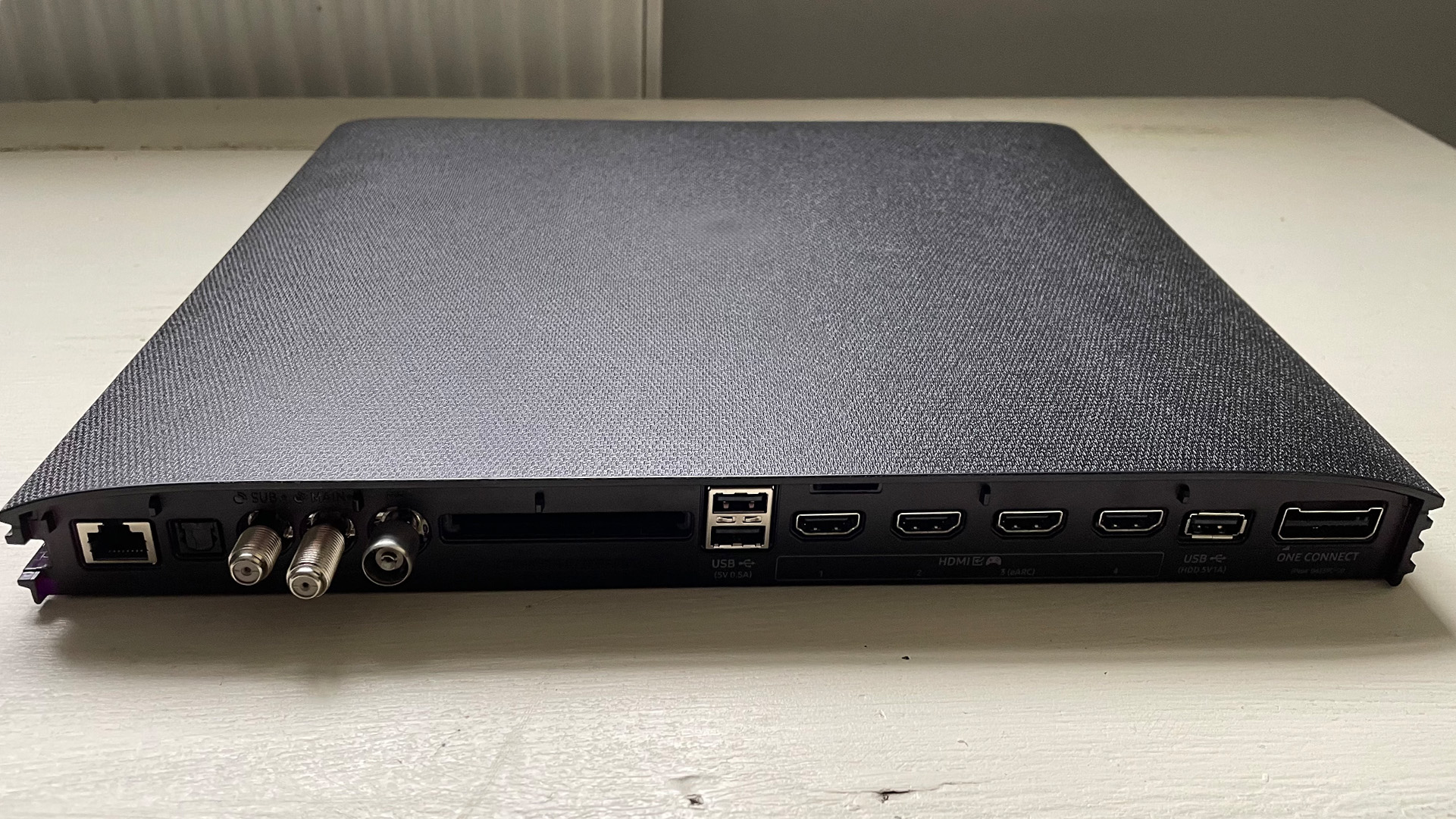
- Third-generation QD-OLED tech, which combines OLED with Quantum Dots
- Impressive anti-reflection filter
- Superb gaming specs and very good smart platform
The S95D’s most instant attraction is that it’s the third generation of television to use Samsung’s QD-OLED technology. This uses a blue organic light shone through red and green Quantum Dot layers to produce its pictures, resulting in a ‘pure’ RGB colour reproduction without the additional brightness-boosting white element used by standard WRGB OLED (often referred to as ‘WOLED’) screens.
All OLED screens, of course, benefit from self-emissive pixels that are each capable of producing their own light and colour independently of their neighbours, resulting in local contrast and lighting controls that not even the most high-end LCD TVs can rival.

Screen size 65 inches (also available in 55in, 77in)
Type QD-OLED
Backlight N/A
Resolution 4K
HDR formats HLG, HDR10, HDR10+
Operating system Tizen
HDMI inputs x 4 (4 x 48Gbps HDMI 2.1)
Gaming features 4K/120Hz, VRR, ALLM
Input lag 9.1ms (60Hz)
ARC/eARC eARC
Optical output? Yes
Dimensions (hwd, without stand) 83 x 144 x 1cm
Where the Samsung S95D most moves the QD-OLED dial forward is with its brightness. Watching HDR content reveals a substantial brightness benefit over the S95C, despite that 2023 model itself pushing the brightness envelope for OLED screen technology. With HDR highlights in particular, the scale of the S95D’s brightness increase looks to be between 20 and 30 per cent over its predecessor. As such, it’s clearly the brightest OLED screen the TV world has seen to date, by an order of magnitude that all OLED rivals for 2024 (and many premium LCD TVs, come to that) will likely struggle to match.
Just as instantly noticeable as the S95D’s stunning extra brightness, though, is how immune the screen is to reflections from your room. Thanks to a new anti-reflection filter on the screen’s front, your common and garden reflections – light-coloured chairs and sofas, loud shirts, faces and so on – are suppressed pretty much completely, even on very bright days.
Even direct ultra-bright light sources hitting the screen – sunlight from an opposite window, say, or a peskily positioned wall light – are reduced to faint, highly contained light ‘balls’ that are only minimally distracting over regular TV footage. This suppression of reflections happens, too, without distracting ‘rainbows’ of light extending across the screen, which is what we’ve seen with some previous, much less potent Samsung reflection-reducing filters.
We’ll talk more about how this filter affects the viewing experience later, but rest assured it’s much more of a big deal (in a good way) than most claimed anti-reflection filters are.
Exciting though it is to see the Samsung S95D emit so much brightness while soaking up so much ambient light, it could all ultimately amount to nought if the TV hasn’t backed that brightness up with sufficient colour saturation and light control. So it’s gratifying to see the S95D packing a new Neo Quantum 4K AI Gen 2 processor that brings the combined brainpower of a claimed 20 separate neural networks to bear on every frame of the picture.
There are many strings to this new processor’s bow, of course. Better upscaling of sub-4K content has been the most obvious beneficiary of AI techniques in recent years, and sure enough, the S95D claims to have improved its upscaling again. There’s also a new Real Depth Enhancer that identifies the main subjects of an image and gently manipulates the way the subjects and background elements appear to create a more three-dimensional and lifelike look.
Also very promising given the way 2023’s S95C could occasionally leave very bold colours looking a little flared out is a new OLED HDR Pro system designed to deliver more accurate colour mapping from the QD-OLED panel – with results that are validated by the colour gurus at Pantone, no less.
The new processor’s workings aren’t restricted to picture features, though. It also drives the latest version of Samsung’s Object Tracking Sound+ system, where a multi-channel speaker system is used to place sound effects in the correct place on – and just off – the S95D’s screen. This system now works with Dolby Atmos sound mixes too, just as we have always said it should.
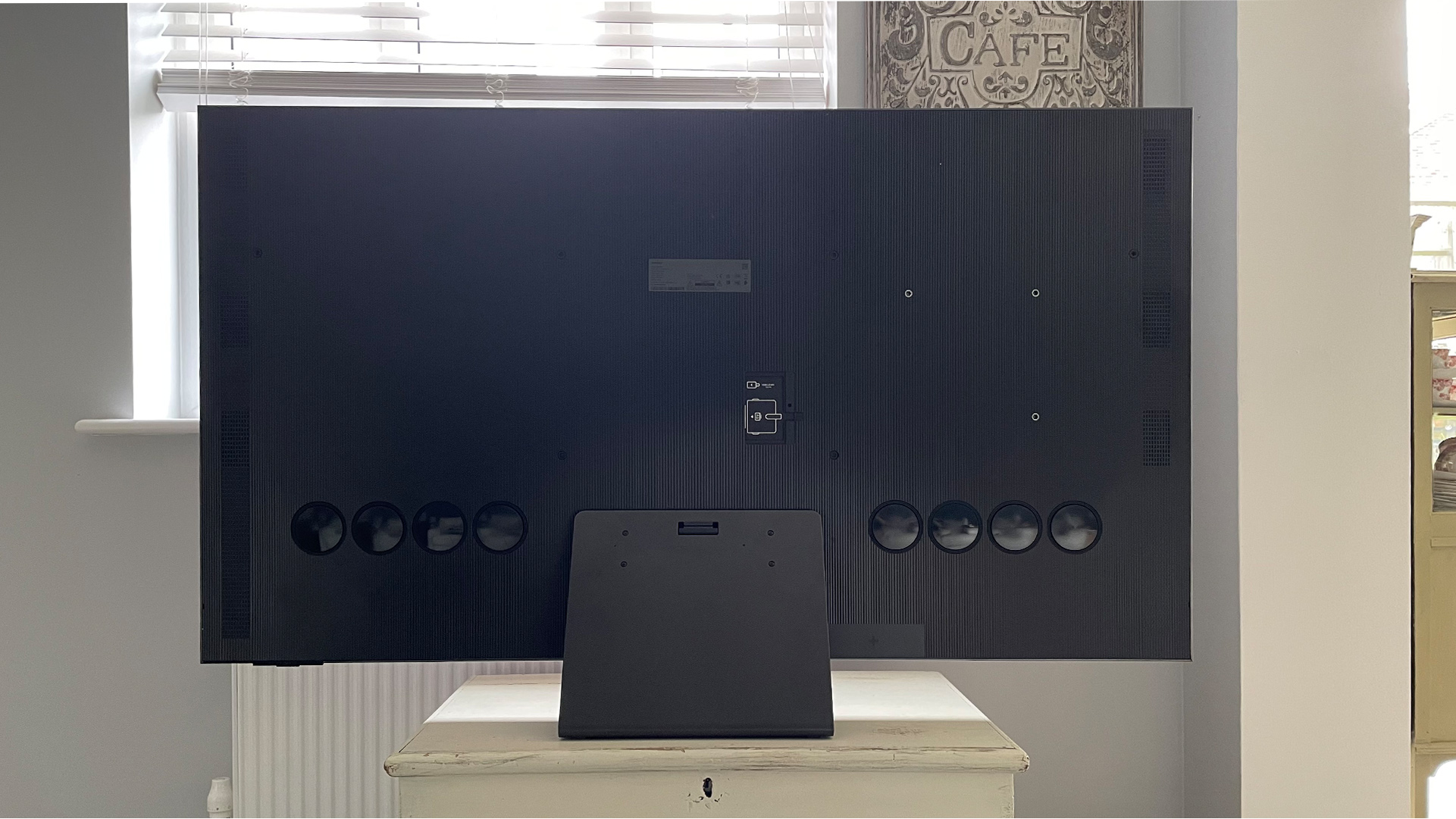
The latest version of Samsung’s Tizen OS smart system is powered by the S95D’s new processor too, helping it run more slickly and stably than it has before – despite the system having a few new features to handle. These new tricks include a profile system that enables different members of your household to set up their own home screens and ‘learned viewing behaviour’ databases, and a new For You content accumulator that brings together everything from broadcast and streamed TV shows you’ve been watching to recommended content from all your available sources based on your learned viewing habits.
Last but by no means least on the S95D’s epic list of features is its pretty extreme gaming support. This includes 4K/120Hz playback, 144Hz frame rate support, an HDR game mode that keeps input lag to just 9.8ms, ALLM switching, a Game Hub that collates all your streamed and connected gaming services and devices together on a single Tizen OS screen, and a Game Bar onscreen menu of graphics information and gaming aids.
The only missing gaming feature is a Dolby Vision Game mode, which isn’t surprising given that no Samsung TV has ever supported any sort of Dolby Vision playback. As with its stablemates, the S95D is limited to HDR10, HLG and HDR10+ (the latter of which, like Dolby Vision, uses extra scene-by-scene picture data to help compatible TVs deliver a more accurate HDR picture).
Picture
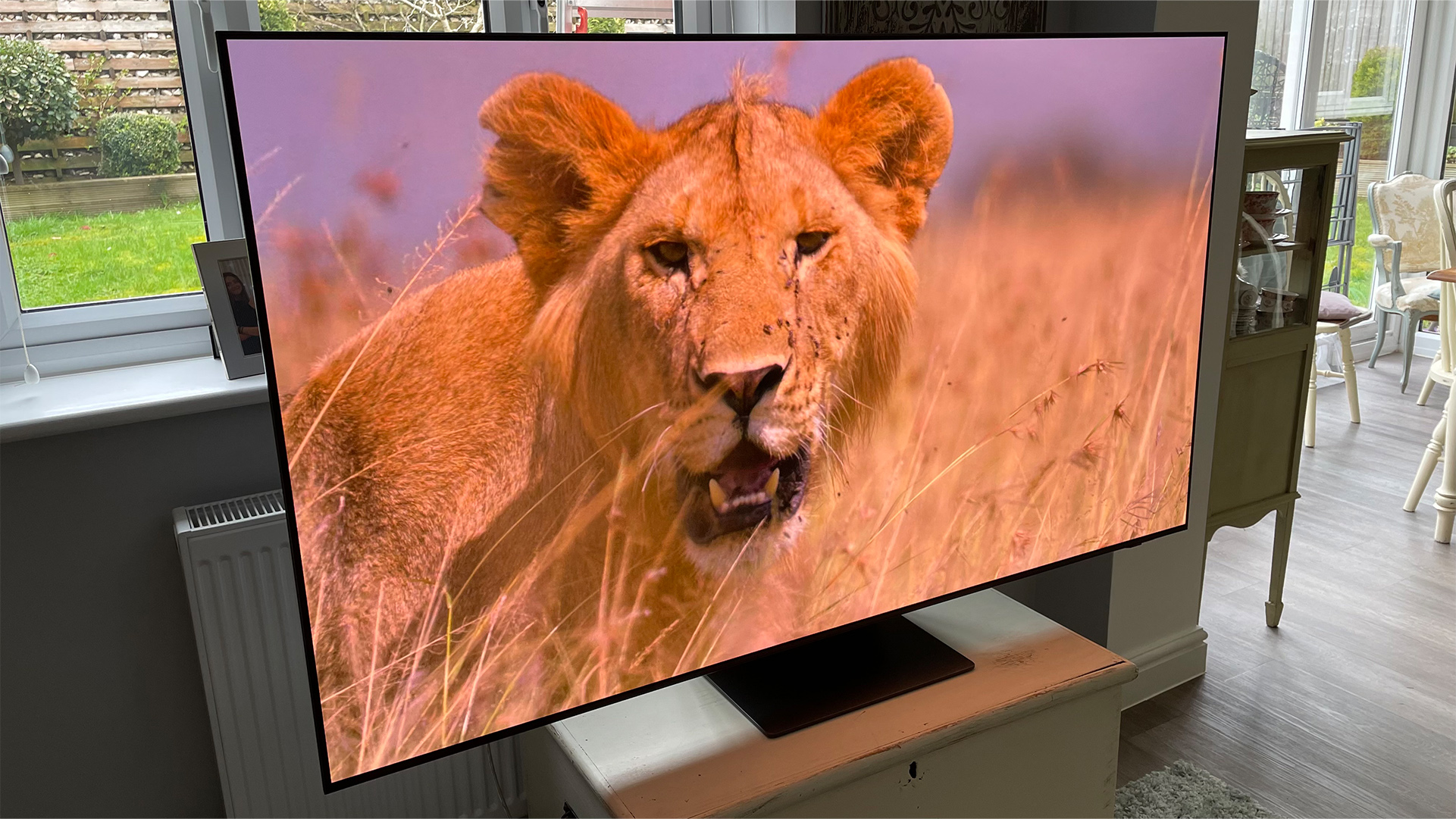
- Exceptional brightness combined with perfect OLED blacks
- Super-vibrant colours but with more balance than previous Samsung OLEDs
- Very sharp and detailed
Once upon a time, the ‘wow’ factor with OLED TVs depended on their stunning black levels and ability to put small bright highlights within that blackness without any loss of intensity. With the Samsung S95D, though, the first thing that hits you is how genuinely bright it is. Not just by OLED TV standards, but by the standards of any current mass-market TV technology.
Feeding the S95D some of the most aggressively mastered titles in our 4K Blu-ray collection – including Pan, Mad Max: Fury Road, and It Chapter One – results in pictures of extraordinary intensity, as blisteringly bright peak white highlights and fantastically richly saturated colours share the screen with the same stunningly deep black colours that OLED TVs are more typically loved for.
The resulting sense of contrast is beyond that of any TV we’ve previously reviewed, and this is even true with the S95D’s stellar Movie mode as well as the punchier Standard mode. Yet whereas this sort of extreme contrast and massive colour volume delivery might have been expected to result in some imbalances, clipping and gaudiness under the tutelage of 2023’s S95C panel drivers and processors, on the S95D everything holds together quite beautifully.
Provided that you avoid Samsung’s always over-optimistic Dynamic preset and don’t set the colour output to ‘Native’, the latest processing and picture management systems deliver even the brightest, purest colours without them looking cartoonish, and without any particular tones appearing with more dominance than they should.
It’s worth noting that as well as breathing spectacular contrast life into pictures during dark room viewing sessions, the S95D’s ground-breaking brightness makes it the best OLED TV yet for bright rooms. An achievement that’s turned up to 11, as Spinal Tap would say, by the extraordinary reflection-suppressing efforts of the new anti-glare filter. This filter’s efforts make it much easier to feel connected with the S95D’s pictures (even dark ones) in a bright room than it ever could be where you have loads of reflections littered across the screen.
There’s less clipping of subtle colour and peak light details in the brightest of bright shots than you got with the S95C, meaning the picture looks more consistently detailed and three-dimensional. The impact of the Real Depth Enhancer system is clearly evident and consistently lovely rather than forced or unnatural, too. And all this finer mapping of colour tones across a wider colour volume means the picture often looks sharper and crisper than that of its predecessor. Especially if you compare the two models’ Movie presets.
While we think most users will likely prefer to use the Standard or, especially, Movie presets, as they carefully give you more of the brightness and intensity Samsung’s astounding new panel is capable of, the Filmmaker Mode is still there for users who want a very accurate picture without having to get a professional calibration done.
The S95D’s handling of very dark scenes – which are made to look if anything even more spectacular by the brightness they can sit alongside – look stable, with no ‘floating black levels’. Noise can occasionally, with particularly extreme dark shots, look a touch strong in Standard mode, but Movie mode, again, typically sorts this out.
Viewing angles are pretty much infinite, as usual with modern OLED TVs. And provided you don’t stick with the rather heavy-handed default motion settings (found under the Picture Clarity area of the onscreen menus), instead choosing a Custom mode, setting judder and blur reduction to their three or four levels and turning off Noise Reduction, movement doesn’t cause the image to lose its spectacular sharpness or be impacted by the ‘soap opera effect’.

This penchant for detail and clarity is retained superbly with HD content by the S95D’s upscaling system. This does a particularly good AI-inspired job of spotting the difference between natural grain and mastering noise in HD sources of all provenances, resulting in beautifully filmic upscaled results that look clean without feeling scrubbed of detail or soft.
There is, though, one limitation and a trio of genuine niggles to report with the S95D’s pictures. The limitation is that while the picture looks fabulously bright and intense with most content, that brightness still takes a hit compared with premium LCD TVs when the screen has to show an HDR image that floods the whole screen (rather than just parts of the screen) with brightness.
The first niggle is that the in-most-ways incredible anti-reflection filter can cause black levels to look a touch raised in bright rooms, and cause limited and faint traces of blooming around extremely stand-out bright objects. But overall we feel that the filter’s benefits – in regular living room conditions, anyway – far outweigh the negatives.
The second niggle is that in the typically gorgeous-looking Standard mode you can occasionally see minor dips and jumps in the image’s underlying brightness level between cuts. This only happens during fairly bright scenes, and the extent of the brightness shift is small. But it’s still another reason why particularly golden-eyed AV fans might want to stick with the Movie preset, particularly for film nights.
The final issue is that there’s a little loss of subtle shadow details in dark areas. This is less stark than it was with the S95C, especially in Movie mode again. But, for instance, the shaded half of faces lit from one side in Top Gun: Maverick, for instance, can look just that bit too shady.
These complaints feel like the proverbial needles in a haystack, though, compared with the number of things the S95D gets spectacularly right. Samsung’s flagship QD OLED set is so good, in fact, and so evolved from its predecessor, that it almost feels like the birth of a new TV species.
Sound
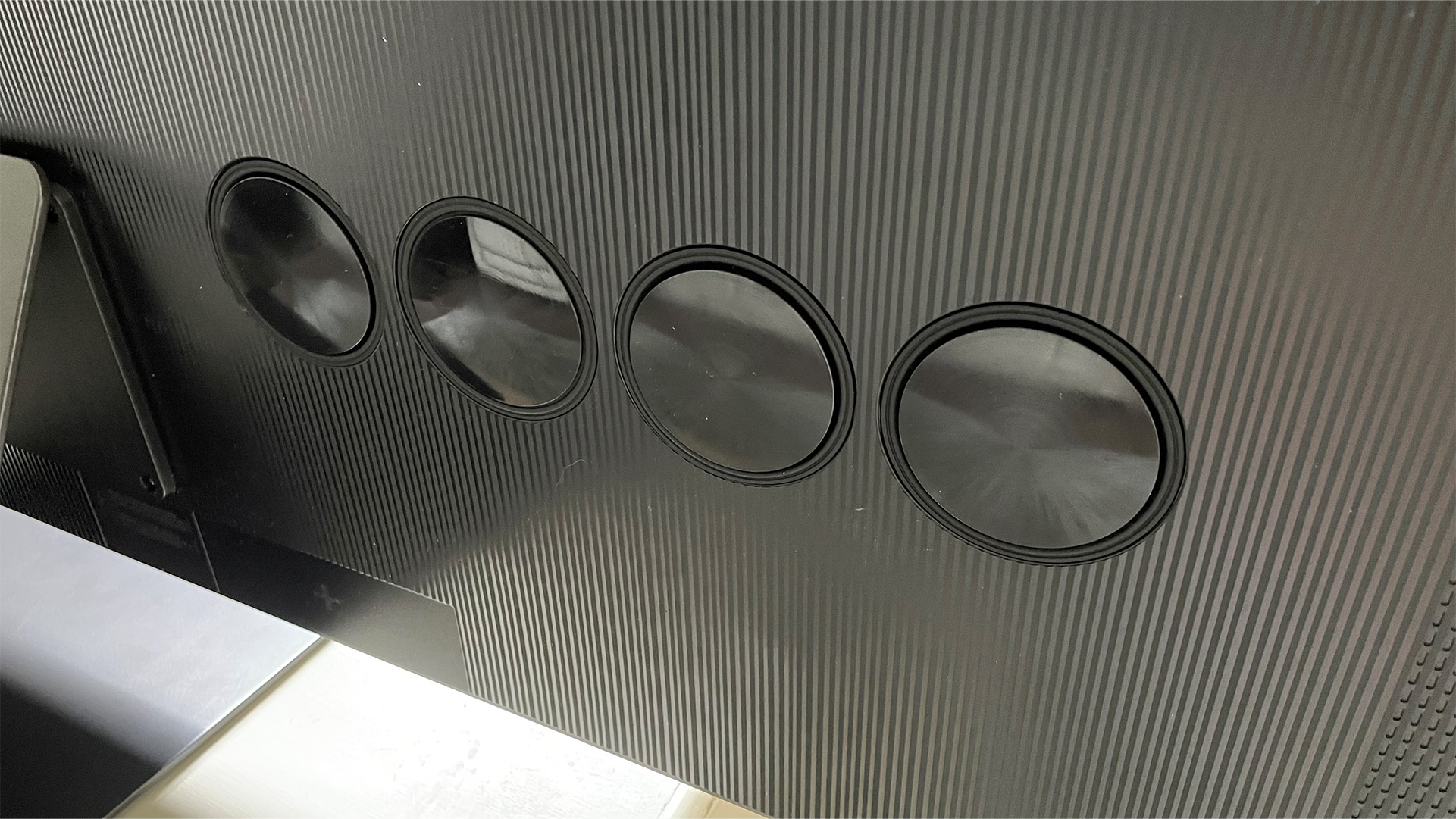
- Good height and width to sound
- Decent detail and clear dialogue
- Weak projection, volume and dynamic range
After the eye-popping home cinema delights of the S95D’s pictures, its sound feels a bit… deflated.
Samsung’s object-tracking sound system is on pretty good form, creating a soundstage that extends in width and height beyond the edges of the screen. It also places sounds into that space with quite startling accuracy, even managing to portray the path of moving noisy objects as they cross or circle the screen.
Details typically sound clean and plentiful too, without becoming ‘overlapped’ or vague, and dialogue is generally handled quite well, retaining clarity no matter how much racket there might be to compete with.
Unfortunately, though, the sound’s ‘spread’ doesn’t include a forward component, leaving it feeling like a rather flat experience that just happens in front of you, rather than something more immersive. Even at maximum volume, meanwhile, the S95D’s sound struggles to produce compelling, cinematic levels of noise, and the dynamic range is too limited and the bass too vague to give movie soundtracks much scale or weight.
We can, though, finish on the positive note that, unlike some Samsung TVs, this QD-OLED model’s sound does usually avoid crackle and distortion.
Verdict
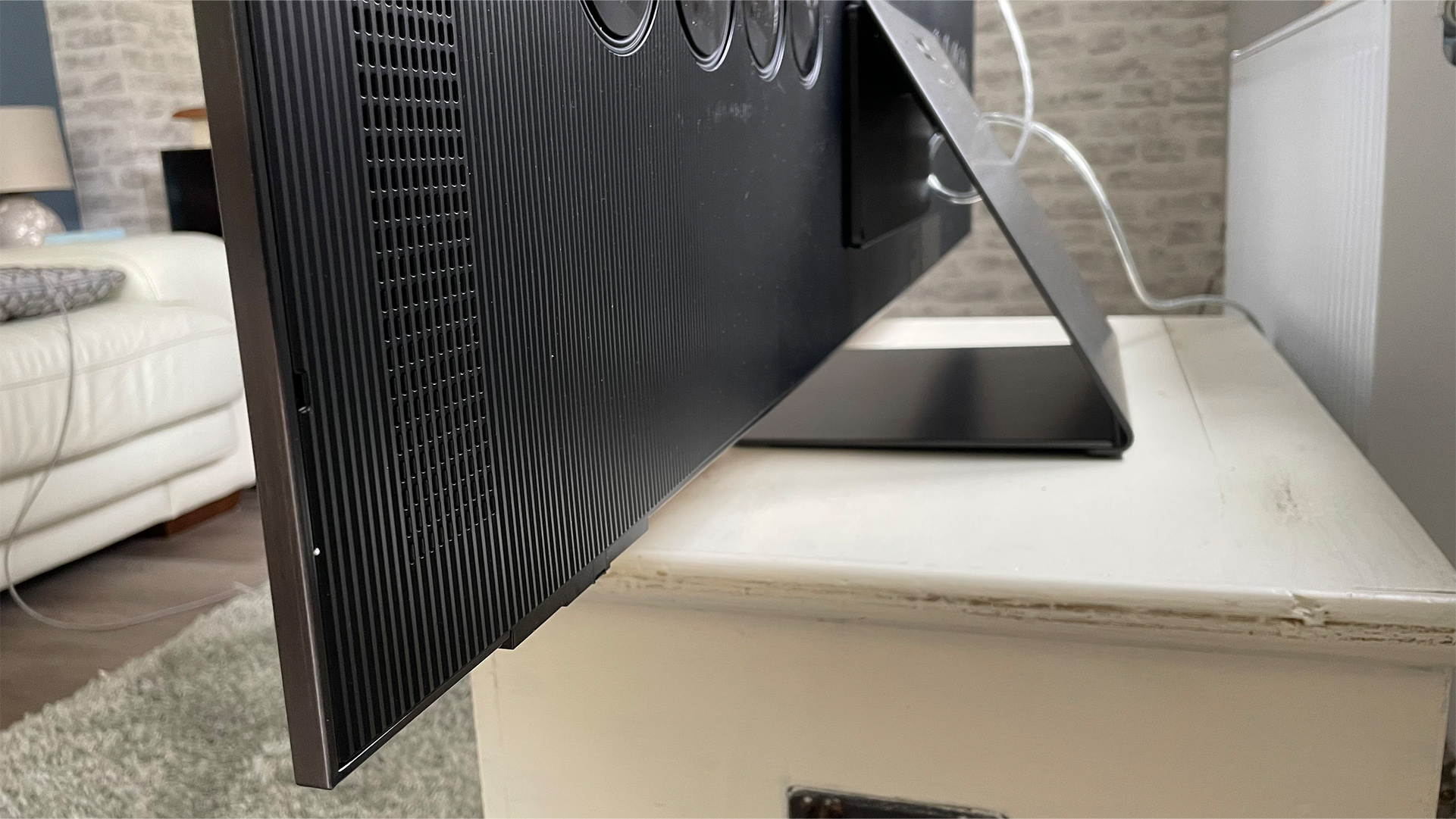
Samsung’s latest QD-OLED hero isn’t just better than its already technically impressive predecessor – it’s so much better that it might just be one of those genuine ‘moments’ in TV development that alters traditional thinking about the roles different types of TV technology have in today’s AV world.
We still, of course, have new 2024 MLA OLED TVs to review from the likes of LG, Panasonic and Philips, but the S95D has set a very high bar indeed for those sets.
SCORES
- Picture 5
- Sound 3
- Features 5
Also consider
As well as the upcoming Panasonic Z95A and Philips OLED909, which we haven't yet reviewed, you should also add these models to your shortlist if you're considering the Samsung S95D:
Recent updates
6th August 2024
Added 'also consider' section.
27th March 2024
Date of original review.
MORE:
Also consider the LG OLED65G3
Read our Sony XR-65A95L







